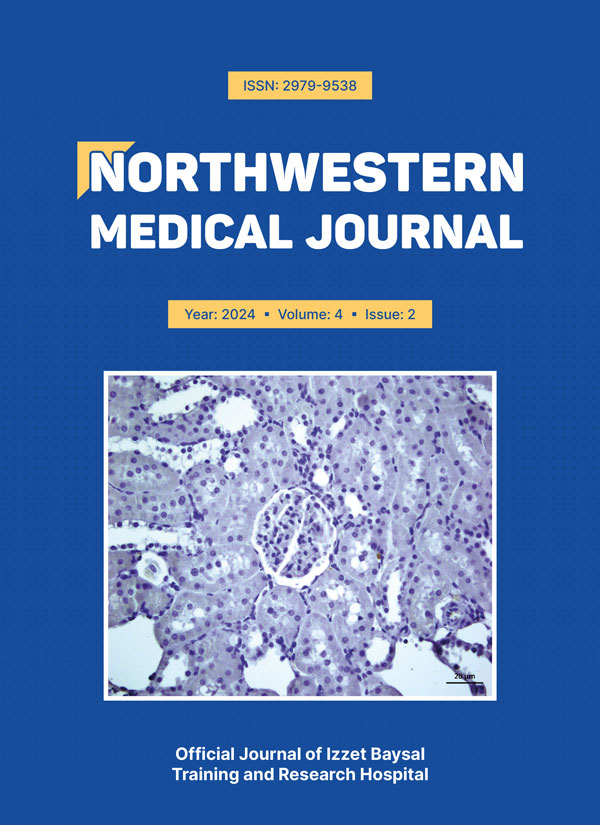Abstract
Aim: Our study aimed to determine the antibiotic resistance rates of K. pneumoniae by retrospectively examining the results of urine culture samples studied in our laboratory.
Methods: Urine samples with K. pneumoniae growth, sent to our laboratory from various wards, outpatient clinics, and intensive care units between July 1, 2018 and December 31, 2022 were included in the study and retrospectively examined.
Results: The antibiotic to which K. pneumoniae was most resistant was cefixime (53.3%), and the antibiotic to which it was least resistant was imipenem (12.1%). While the lowest resistance rates were observed in the samples of outpatients, the highest resistance rates were observed in the samples of ward patients and to cefixime (81%), amoxicillin clavulanic acid (AMC) (80%), trimethoprim-sulfamethoxazole (TMT/SXT) (74.8%), and ciprofloxacin (72.1%). Ertapenem (48.9%), meropenem (50.2%) and piperacillin-tazobactam (PRP) (57.3%) resistance was found to be higher in intensive care patients.
Conclusion: Although fluctuations in resistance rates have been observed over the years, resistance rates have generally been found to be high for antibiotics frequently used in the empirical treatment of urinary tract infections. Re-adjusting treatment according to culture results and keeping resistance rates in mind for empirical treatment will be important for treatment success.
Keywords: antibiotic resistance, Klebsiella Pneumoniae, urine cultures
Copyright and license
Copyright © 2024 The Author(s). This is an open-access article published by Bolu İzzet Baysal Training and Research Hospital under the terms of the Creative Commons Attribution License (CC BY) which permits unrestricted use, distribution, and reproduction in any medium or format, provided the original work is properly cited.
How to cite
References
- Podschun R, Ullmann U. Klebsiella spp. as nosocomial pathogens: epidemiology, taxonomy, typing methods, and pathogenicity factors. Clin Microbiol Rev. 1998; 11(4): 589-603. https://doi.org/10.1128/CMR.11.4.589
- European Centre for Disease Prevention and Control. Antimicrobial resistance in the EU/EEA (EARS-Net): Annual Epidemiological Report for 2019. Available at: https://www.ecdc.europa.eu/en/publications-data/surveillance-antimicrobial-resistance-europe-2019 (Accessed on April 15, 2021).
- Marston HD, Dixon DM, Knisely JM, Palmore TN, Fauci AS. Antimicrobial Resistance. JAMA. 2016; 316(11): 1193-204. https://doi.org/10.1001/jama.2016.11764
- Antimicrobial Resistance Collaborators. Global burden of bacterial antimicrobial resistance in 2019: a systematic analysis. Lancet. 2022; 399: 629-55. https://doi.org/10.1016/S0140-6736(21)02724-0
- Gülcan A, Aslantürk A, Gülcan E. The Microorganisms Isolated From Urine Culture and Their in Vitro Antibiotic Susceptibility. Abant Tıp Dergisi. 2012; 1(3): 129-35.
- Şenol A, Yakupoğulları Y, Şenol FF. Extended-Spectrum β-Lactamase-Producing Escherichia coli and Klebsiella spp. in Community-Acquired Urinary Tract Infections and Their Antimicrobial Resistance. Klimik Derg. 2020;33(2):163-8. https://doi.org/10.5152/kd.2020.34
- European Association of Urology (EAU). EAU Guidelines on Urological infections. 2020. Available at: https://d56bochluxqnz.cloudfront.net/documents/EAU-Guidelines-on-Urological-infections-2020.pdf (Accessed on January 25, 2021).
- The European Committee on Antimicrobial Susceptibility Testing. Breakpoint tables for interpretation of MICs and zone diameters. Version 9.0, 2019. Available at: https://www.eucast.org/fileadmin/src/media/PDFs/EUCAST_files/Breakpoint_tables/v_9.0_Breakpoint_Tables.pdf (Accessed on October 10, 2020).
- Khoshnood S, Heidary M, Mirnejad R, Bahramian A, Sedighi M, Mirzaei H. Drug-resistant gram-negative uropathogens: A review. Biomed Pharmacother. 2017; 94: 982-94. https://doi.org/10.1016/j.biopha.2017.08.006
- Dellit TH, Owens RC, McGowan JE, et al. Infectious Diseases Society of America and the Society for Healthcare Epidemiology of America guidelines for developing an institutional program to enhance antimicrobial stewardship. Clin Infect Dis. 2007; 44(2): 159-77. https://doi.org/10.1086/510393
- Balıkçı H, Açıkgöz ZC, Güvenman S, Celikbilek N, Ozdem B. Detection of plasmid-mediated AmpC beta-lactamase production in Escherichia coli and Klebsiella spp. isolates. Mikrobiyol Bul. 2014; 48(1): 82-93.
- European Centre for Disease Prevention and Control. Antimicrobial resistance surveillance in Europe 2023 - 2021 data. Available at: https://www.ecdc.europa.eu/en/publications-data/antimicrobial-resistance-surveillance-europe-2023-2021-data
- Temoçin F, Köse H. Evaluation of Extended Spectrum Beta-lactamase Production Rates and Antibiotic Susceptibilities of Escherichia coli and Klebsiella pneumoniae Strains Isolated from Urine Cultures of Outpatients. ANKEM Derg. 2018; 32(3): 79-86. https://doi.org/10.5222/ankem.2018.1811
- Eroğlu M, Koçoğlu E, Karabay O, Semerciöz A. Antimicrobial Susceptibility of Enterobakteriacea Species Causing Community Acquired Urinary Tract Infection: A Retrospective Study. Turk Urol Derg. 2007; 33(1): 100-3.
- Aytaç Ö, Mumcuoğlu İ, Çetin F, Aksoy A, Aksu N. The antibiotic susceptibility changes of the Escerichia coli strains isolated from community-acquired urinary tract infections in adults according to the years (2010-2014). Turk Hij Den Biyol Derg. 2015; 72(4): 273-80. https://doi.org/10.5505/TurkHijyen.2015.82642
- Duran H, Çeken N, Kula Atik T. Antibiotic Resistance Rates of Escherichia coli and Klebsiella pneumoniae Strains Isolated from Urine Culture: A Four-Year Analysis. ANKEM Derg. 2020; 34(2): 41-7. https://doi.org/10.5222/ankem.2020.041
- Coşkun B, Ayhan M. Evaluation of Community-acquired Lower Urinary Tract Infections. Ankara Üniversitesi Tıp Fakültesi Mecmuası. 2022; 75(3): 388-93. https://doi.org/10.4274/atfm.galenos.2022.76598
- Karamanlıoğlu D, Yıldız PA, Kaya M, Sarı N. Extended-Spectrum β-Lactamase Production Rates and Antibiotic Susceptibilities Among Enterobacteriaceae Isolated From Urine Cultures. Klimik Derg. 2019; 32(3): 233-9. https://doi.org/10.5152/kd.2019.68
- Karabay O, Baştuğ A, Öztürk R, et al. Antibiotic Consumption, Resistance Data, and Prevention Strategies. Mediterr J Infect Microb Antimicrob. 2018; 7(35): 1-39. https://doi.org/10.4274/mjima.2018.35
- Aykan SB, Ciftci IH. Antibiotic resistance patterns of Escherichia coli strains isolated from urine cultures in Turkey: a meta-analysis. Mikrobiyol Bul. 2013; 47(4): 603-18. https://doi.org/10.5578/mb.6383
- Şenol FF, Bahçeci İ, Aytaç Ö, Öner P, Toraman ZA. Antibiotics resistance rates of gram negative esbl positive bacteria isolated from various clinical specimens. Turk J Clin Lab. 2021; 12(4): 451-7. https://doi.org/10.18663/tjcl.956156
- Doğanay D, Aydın M, Avşar İS. Investigation of the antibiotic resistance profile of klebsiella pneumoniae isolates isolated from different clinical specimens: One year data during the COVID-19 pandemic process. Journal of Faculty of Pharmacy of Ankara University. 2023; 47(1): 185-95. https://doi.org/10.33483/jfpau.1181432











